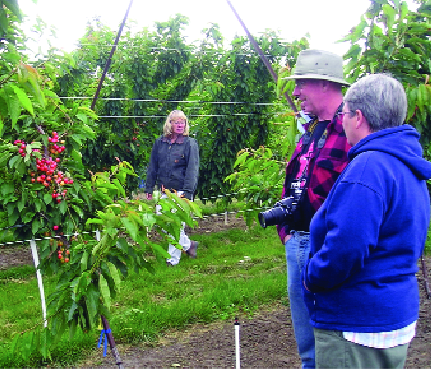
Dena Ybarra of Quincy (center) and Mike and Pat Beulah of British Columbia, Canada, look at the quality of the cherries during the WSU cherry field day at Prosser, Washington.
By Anne Sampson
Extenday reflective fabric grabbed the spotlight during the annual Washington State University cherry field day this summer. Growers and breeders from across the Pacific Northwest gathered at the Roza test plot at the Irrigated Agriculture Research and Extension Center near Prosser, walking the carpeted rows and examining the crop for size, color and firmness.
Research horticulturist Dr. Matthew Whiting presented results of research designed to help growers improve fruit size and crop load, including tests of chemical blossom thinners and a study of cellular morphology in sweet cherries. “Our tests last year showed using Extenday advanced maturity about five days,” Whiting reported.
“This year, it looks to be more like three or four days.” Extenday is a reusable reflective ground cover. Rolled out between trees, it enhances a tree’s use of sunlight, resulting in improved color, maturation, firmness, and sweetness. For the first tests in 2004, Whiting applied Extenday between rows of Bing cherries at full bloom, then removed the fabric two weeks after harvest.
“We saw no effect on fruit size, but higher firmness at harvest and after two weeks in cold storage,” he said. This season, Whiting’s research went one step further, testing Extenday’s ability to produce bigger fruit. He looked at the effect of Extenday on Rainier cherries by collecting data from grower Larry Haak, who applied the fabric at his orchard in Outlook.
Haak rolled out the fabric in three phases: two weeks prior to bloom, at full bloom, and three weeks before harvest. He said about half of the first batch was transferred after four weeks to his Gala trees, then returned to the cherry rows after another four weeks. “To the naked eye, I could see no difference between the trees where Extenday was applied early,” he said.
“But I could see a definite difference between all of those cherries and those where Extenday wasn’t used until two or three weeks before harvest.” All the tests were done in comparison with trees exposed to Mylar. Haak said the fabric helped him produce a crop of 101⁄2-row Rainiers. “I was very impressed.
It enabled me to carry a larger crop to good size.” Extenday USA President Jonathon Toye, who developed the product in New Zealand, said the fabric improves light and heat in the orchard, particularly to lower branches that are more shaded than the top canopy. Huge bolts of the fabric are unfurled down orchard rows and secured with staples or a rubber wire and claw, then rolled up again at the end of the season.
He displayed simple adaptations to standard farm machinery developed by a New Zealand grower to help install Extenday. His company doesn’t make the equipment, he said, but he’ll provide a free copy of plans for the attachments. Toye acknowledged his product is significantly more expensive than Mylar, but comparing the two is “like comparing a bicycle to a truck,” he said.
“They do different things.” And while Extenday is significantly more expensive than Mylar, it stands up to 30 months of use—enough for five or six growing seasons. “It remains to be seen over the long haul what the cost difference really is,” Haak said. “I can drive a tractor over it and still reuse it. I can’t do that with Mylar. “If you want to be competitive growing Rainiers,” he added, “you have to use Extenday.”
Haak saw a distinct difference between the cherries exposed to Extenday early in the season and those exposed to it only a few weeks before harvest. Those trees with full-season exposure to the reflective fabric produced bigger, firmer fruit, while also showing enhanced color and sweetness gained late in the season.
It also had a significant effect on early yield. The trees exposed to Extenday at Haak’s orchard produced four to five times as much fruit on the first pick as trees treated with Mylar, according to Whiting. But, he added, the increased yield might have affected the maturation process. In 2005, the Extenday crop appeared to be about three or four days ahead of other trees, instead of the five-day lead observed in 2004.
Whiting’s study on cellular morphology provided a possible explanation. Microscopic examinations of cells in a variety of fruits revealed that size of the cells dictated size of the fruit, rather than the number of cells as was previously thought. This has immediate impact, Whiting said, because if you believe that fruit size is caused by the number of cells, you’re going to concentrate your efforts as the fruit matures, rather than earlier in the season, when the size of fruit cells can best be affected.
Blossom thinning
Whiting also discussed his research on chemical blossom thinning to improve fruit size and quality. He applied four different substances—ammonia thiosulfate, a fish oil and lime/sulfur mix, Turgitol, and a vegetable oil emulsion. The first application was applied at 20 percent bloom, followed by a second spray at 80 to 90 percent bloom.
The fish oil with lime/sulfur was the most effective at thinning blossoms. Research now will focus on how the chemical thinners do their job. “They might be caustic substances, or they might reduce photosynthesis,” he explained.
Whiting said chemical blossom thinning is an important piece of successful crop-load management systems. Hand thinning of fruit late in the season can help improve fruit size, he said, “but chemical thinning is more sustainable. It means you can manage your crop at the blossom stage. We’re trying to balance crop load with the ability of a canopy to produce large fruit.”




Leave A Comment